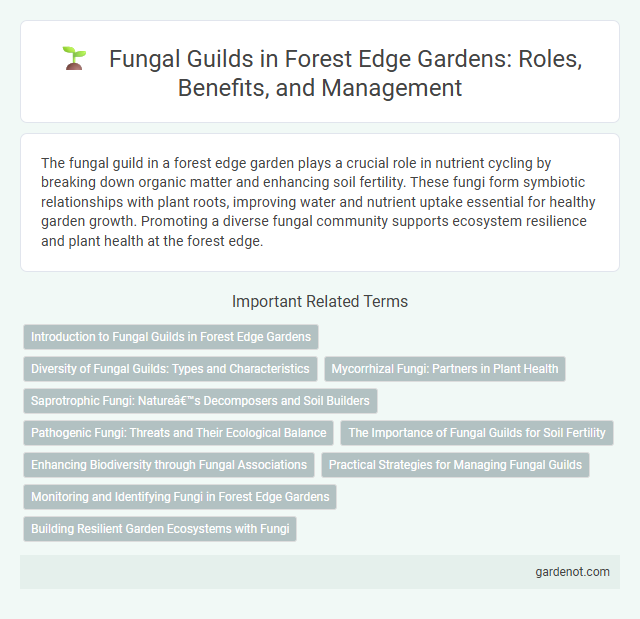The fungal guild in a forest edge garden plays a crucial role in nutrient cycling by breaking down organic matter and enhancing soil fertility. These fungi form symbiotic relationships with plant roots, improving water and nutrient uptake essential for healthy garden growth. Promoting a diverse fungal community supports ecosystem resilience and plant health at the forest edge.
Introduction to Fungal Guilds in Forest Edge Gardens
Fungal guilds in forest edge gardens play a critical role in nutrient cycling and plant health by forming symbiotic associations with tree roots, such as mycorrhizal fungi. These fungi enhance water and nutrient uptake, improving soil fertility and promoting resilient plant growth in the diverse microhabitats of edge environments. Understanding the composition and function of fungal guilds supports sustainable forest edge management and biodiversity conservation.
Diversity of Fungal Guilds: Types and Characteristics
Fungal guilds in forest edge gardens exhibit remarkable diversity, including mycorrhizal fungi, saprotrophs, and pathogens, each playing distinct ecological roles. Mycorrhizal fungi form mutualistic associations with plant roots, enhancing nutrient uptake, while saprotrophs decompose organic matter, recycling essential nutrients back into the soil. Pathogenic fungi influence plant health by controlling populations, making fungal guild diversity crucial for maintaining a balanced and productive forest edge ecosystem.
Mycorrhizal Fungi: Partners in Plant Health
Mycorrhizal fungi form symbiotic relationships with plant roots in forest edge gardens, enhancing nutrient uptake and improving plant resilience. These fungi facilitate the absorption of essential minerals like phosphorus and nitrogen, boosting overall plant growth and health. Their presence fosters a balanced soil ecosystem, supporting a thriving plant community at the forest edge.
Saprotrophic Fungi: Nature’s Decomposers and Soil Builders
Saprotrophic fungi play a crucial role in forest edge gardens by breaking down dead organic matter, recycling nutrients, and enhancing soil fertility. These fungi secrete enzymes that decompose complex materials like lignin and cellulose, accelerating the formation of humus and improving soil structure. Their activity supports plant growth, promotes microbial diversity, and maintains ecosystem health at the forest fringe.
Pathogenic Fungi: Threats and Their Ecological Balance
Pathogenic fungi in forest edge gardens pose significant threats to plant health by causing diseases that reduce growth and yield, impacting biodiversity and ecosystem stability. These fungi disrupt nutrient cycling and soil structure, altering the delicate ecological balance essential for plant and microbial communities. Effective management of pathogenic fungi is crucial to maintaining plant resilience and supporting the overall health of forest edge ecosystems.
The Importance of Fungal Guilds for Soil Fertility
Fungal guilds play a critical role in enhancing soil fertility within forest edge gardens by facilitating nutrient cycling and organic matter decomposition. Mycorrhizal fungi form symbiotic relationships with plant roots, improving water and nutrient uptake, particularly phosphorus and nitrogen. These fungi also contribute to soil structure stability, promoting healthy root development and increasing overall ecosystem productivity.
Enhancing Biodiversity through Fungal Associations
Fungal guilds play a vital role in forest edge gardens by forming symbiotic relationships with plant roots, enhancing nutrient cycling and soil health. These fungi improve plant resilience and growth by facilitating nutrient exchange and protecting against pathogens, thereby increasing biodiversity within the ecosystem. Promoting diverse fungal communities supports a more robust and sustainable garden environment at the forest edge.
Practical Strategies for Managing Fungal Guilds
Effective management of fungal guilds in forest edge gardens involves promoting beneficial mycorrhizal fungi through organic mulching and minimal soil disturbance to enhance nutrient cycling and plant health. Implementing crop diversity and integrating specific plants that encourage symbiotic fungi can suppress pathogenic species and improve soil resilience. Monitoring soil moisture and pH levels supports fungal balance, optimizing ecosystem productivity and reducing disease outbreaks.
Monitoring and Identifying Fungi in Forest Edge Gardens
Monitoring and identifying fungi in forest edge gardens involves systematic observation and collection of specimens to document fungal diversity and their ecological roles. Techniques such as spore print analysis, DNA barcoding, and regular photographic records help track fungal species presence and health within microhabitats. Accurate identification informs management practices that support beneficial mycorrhizal relationships, enhancing plant nutrient uptake and soil health at the forest edge.
Building Resilient Garden Ecosystems with Fungi
Fungal guilds play a crucial role in building resilient garden ecosystems by forming symbiotic relationships with plants, enhancing nutrient cycling and soil health. Mycorrhizal fungi increase water and nutrient absorption, improving plant growth and resistance to environmental stress. Incorporating diverse fungal species in forest edge gardens promotes biodiversity, supports natural pest control, and stabilizes ecosystem functions.
Fungal guild Infographic

 gardenot.com
gardenot.com